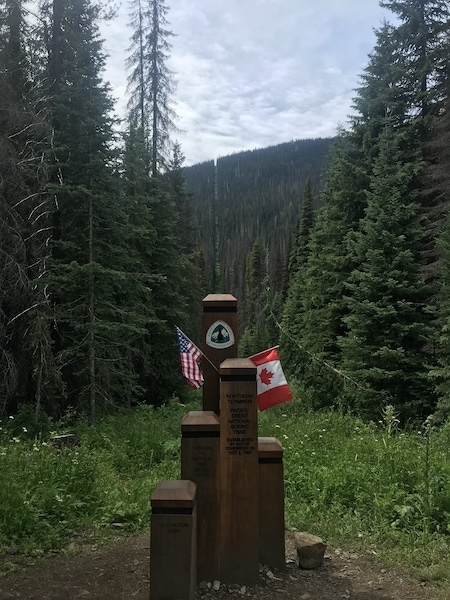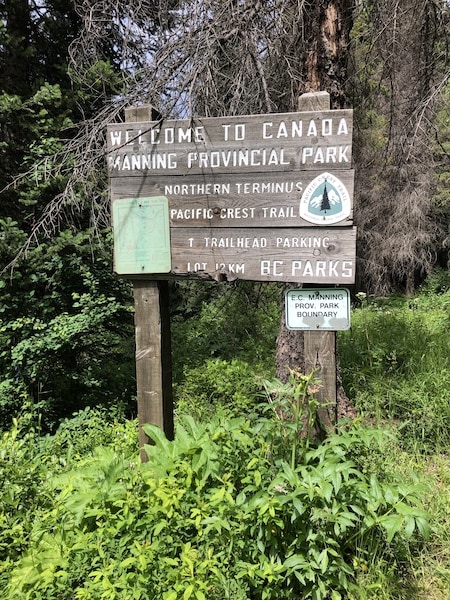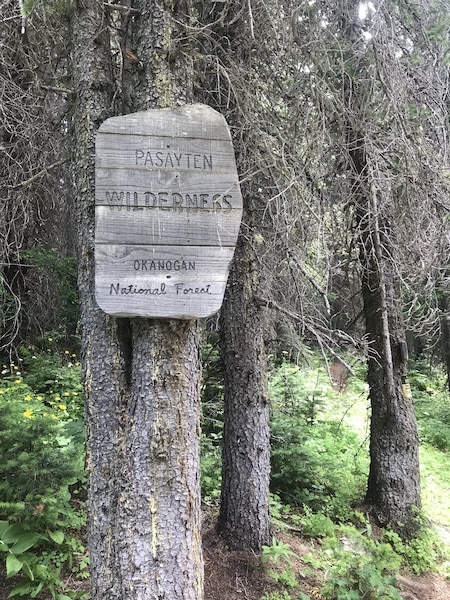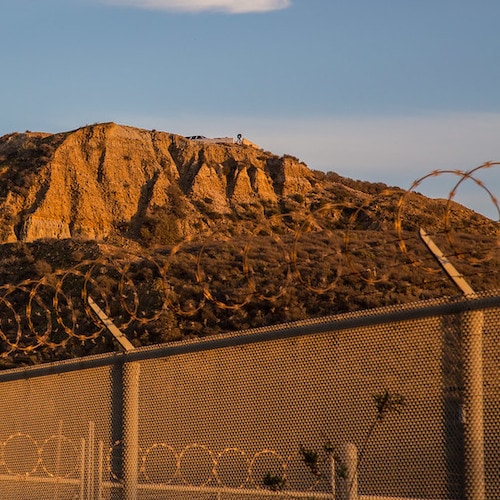An act of walking into the wilderness implies an act of walking out of somewhere or something. The Pacific Crest Trail (PCT), which extends over the US states of California, Oregon and Washington, and connects Mexico to Canada, has long represented an escape from the monotony and materialism of mainstream western society (Fletcher 2014). However, the construction of the PCT as an untouched and thoroughly wild space is only made possible by the systemic erasure of violent social policies and migrant bodies (Kafer 2005). Purported divisions between the “real world” and “wilderness” are increasingly porous as technologies, politics, and materialities seep into the lives of both hikers and migrants. Inviting a folding together of person, place, and thing, the lives and afterlives of the vibrant objects, subjectivities, and landscapes, which inform life on the Pacific Crest Trail, complicate the notion of what it means to walk out of “our” world and into the world of the wild.
Divisions between the “real world” and “wilderness” are increasingly porous as technologies, politics, and materialities seep into the lives of both hikers and migrants.
Beginning at the US-Mexico border, the monument marking the southern terminus of the PCT is dwarfed by The Wall. Each year, this long-distance hiking trail witnesses hundreds of individuals attempting to walk from border to border, as well as thousands of migrants attempting to walk from one country to another. For migrants seeking to enter the US, the trail is both an escape from poverty, famine, and violence, and an exposure to those very things (De Leon, Gokee and Schubert 2015). The fact that the PCT coincides with many of the trails undocumented migrants may take across the border reifies the constructedness of divisions between citizenship and state. Migrants may take the national trail in an effort to reach some form of quasi-nationality.

The PCT materializes not as a place set apart, but a place entwined (Ness 2016), animating the technologies, politics, and materialities that seep into the lives of both hikers and migrants. Rather than exploring the PCT and the US-Mexico borderlands as liminal spaces, I am interested in the ways these spaces bleed into one other, complicating the meaning of both “real” and “life.” While hikers seek to escape American society via the desert, migrants struggle to become a part of American society via that same desert. The tensions between borderland and national land are punctuated by the lives and afterlives of the specific objects that accompany individuals into the wild. From water bottles carried and discarded along the trail by migrants to the water caches left by “trail angels” for thirsty hikers, differences of liveability are brought to matter, revealing a much more entangled world of exposure, violence, and life on the trail.
The tensions between borderland and national land are punctuated by the lives and afterlives of the specific objects that accompany individuals into the wild.
While conducting fieldwork for my master’s research project, I had the privilege of hiking several sections of the PCT in Washington and British Columbia. Upon approaching the Canadian frontier, I was unnerved by how easily I was able to move across the border. While there were no barriers, checkpoints, or people at the US-Canada border on the PCT, the southern terminus of the trail commands multi-million dollar “security measures” to deter migrants at the US-Mexico border. I was unsettled by the juxtaposition of these two landmarks and its implications for the treatment of its disparate migrants. The Wall transforms the act of walking from a personal into a political endeavor. Embodying a collection of disparate meanings, which hinge upon a person’s connection to the place, the steel structure ties together discourses of soil and sovereignty, of suffering and solace. At the southern trailhead of the PCT, it is the crossers, and not the border, who are rendered nearly invisible against the backdrop of the California desert. The power and privilege packed into the ability to walk both in and out of the wilderness become animated by the objects that expedite, enable or infringe upon the movement of particular persons on the trail.
The Wall transforms the act of walking from a personal into a political endeavor.
Although the Pacific Crest Trail and the migrant trails encompass the same landscapes within the US-Mexico borderlands, nature on the national trail emerges as a haven, while on the migrant trail it is deployed as a weapon. In his 2015 ethnography The Land of Open Graves, Jason De Leon exposes the agenda of the US government in its implementation of the Prevention Through Deterrence Program. By heightening security in densely populated areas, border patrol agents force undocumented migrants to cross through the desert. Under the guise of this program, government policies exploit the wilderness and its actants, resulting in a production of mass migrant death, rather than deterrence (De Leon 2015). In 2019, the PCT claimed the life of one prospective hiker (Halfway Anywhere 2020). In that same year, over 800 migrants died attempting to cross the US-Mexico borderlands (UN News 2019).
In June of 2013, when asked to comment on several decomposing bodies found in the wilderness of the US-Mexico borderlands, Tucson Sector Chief Manuel Padilla Jr. dismissively stated, “the desert does not discriminate” (De Leon 2015, 43). But while the desert, may not consciously discriminate as an active, agentic force amongst its victims, the collision of persons, places, things, and powers along the US-Mexico border enables the desert to systematically pick up and discard migrant lives, while simultaneously allowing hikers to walk through the migrant graveyard undeterred, and often unaware. Despite bearing witness to the persecution of innocent individuals, the PCT works to obscure the blood implicit in its soil and preserve the fiction of a natural wilderness journey (Fletcher 2014). Obscuring the lives and afterlives of migrants and their materials, maps encourage thru-hikers to avoid undocumented migrants by outlining precautionary measures such as refraining from hiking at night (Quinn 2015, 19). While the Pacific Crest Trail is monitored by governmental agencies to ensure the safety of its thru-hikers, the migrant trail is monitored to ensure the disappearance of its travelers. Frailty is distributed differently across each trail and the power of the place shifts in accordance with the positionality of the person.
The PCT works to obscure the blood implicit in its soil and preserve the fiction of a natural wilderness journey.
The various objects that accompany hikers and migrants into the wilderness reveal discrepancies in access to money, power, and opportunity. While the popularization of ultralight backpacking has created a culture of hikers that enlist high-tech and often expensive gear to produce packs with the lowest possible base weight, migrants take the ultralight mantra to a new level, out of necessity rather than expediency, typically entering the desert without enough food or water to survive for more than a few days. Differences of power increasingly matter when the matter of modern materialities, although not living, give life, providing individuals with the shelter, sustenance, and strength required to keep on walking. Foucault’s biopower (1978) becomes reworked within the body of the thing, prompting these objects to assume a type of agency (Bennett 2010), through which they possess the power to make hikers live or let them die.

Since the early 2000s, a majority of thru-hikers have become reliant upon the life-giving abilities of modern technologies, such as Emergency SPOT GPS locators (Miller 2014). These machines afford hikers the luxury of choice, as well as the reassurance of rescue. They are imbued with the ultimate power to make hikers live: one only has to press a button to be whisked out of the wilderness. Equipped with an exit strategy, hikers expose the stakes inherent in processes of mattering and unmattering. While the presence of a GPS in a hikers’ pack has the potential to save a life, the same technology on the body of an undocumented migrant has the capacity to stunt a life. Border crossers caught with navigational tools may be charged with smuggling and face jail time, rather than deportation (De Leon 2015). While the operation of a GPS by a hiker in the wild is construed as a personal affair, the possession of that same GPS by a migrant hiking through the wild becomes a potent, political issue.
Frailty is distributed differently across each trail and the power of the place shifts in accordance with the positionality of the person.
Although undocumented migrants are often devoid of the money or power required to access the high-tech gear that thru-hikers employ, migrant technologies enact the power to make live or let die to an even greater degree. A matter of leisure becomes a matter of life (or death). Further emphasizing the politics behind making matter appear natural in the wild, trail angels on the PCT emerge as unsung heroes, leaving caches of food, water, and cold beer on the trail. Increasingly ingrained into the fabric of the PCT, trail magic emerges as a crucial experience for many long-distance hikers, providing them with the motivation and the materials to keep on walking. In contrast to the caches left for thru-hikers, water caches left for migrants are considered a federal offense. Often condemned, tampered with or destroyed, the politicization of migrant matter marks these caches as unnatural and unsavory, degrading both a nation and its nature (De Leon 2015).
When place and thing fail the person, migrants and their matter become folded into the desert landscape. “Natural” processes of decay and decomposition disappear the person, and his or her things, from the social world. Deceased migrants and their discarded matter are reduced, by the American public, to migrant “trash” (Soto 2018). Sidestepping the detrimental environmental impacts of the Border Patrol, border crossers are scapegoated, even in death, for the desecration of the desert (De Leon, Gokee and Schubert 2015). In an effort to preserve the wilderness, “the material signature of migration” has become a focus of desert cleanup projects (Soto 2018), which supplement the power of the desert in making migrant matter un-matter. These projects erase the historical evidence of racialized persecution in the desert with the conflation of artifact and trash (Soto 2018). The agency of place and thing remain highly dependent on the agency, or lack thereof, of the person. Structures of power become enmeshed within the world of the wild, making or unmaking materials and migrants appear as natural or detrimental to the environment.
In line with this process of un-mattering, the bodies and materials of migrants are made to disappear in the desert. Conservation efforts encompassed by the “Leave no Trace” mantra, which is unfailingly recited along the miles of the PCT, are violently replicated along the coinciding miles of the migrant trail. The Prevention Through Deterrence program weaponizes the desert in an effort to “leave no trace” of its undocumented migrants. Signifying a rigid adherence to preservation policies, the moniker “Leave no Trace Nazi” is often assigned to hikers on the PCT as an ironic, yet esteemed, badge of honor (Forestell 2017). This reappropriation of the term “Nazi” is indicative of the processes of modification, sanitization, and extermination that have made the outdoors inhabitable, and the wilderness explorable for white individuals and affluent hikers. In the US-Mexico Borderlands and along the Pacific Crest Trail, the preservation of the environment appears to supersede the preservation of (particular) lives (De Leon 2015).
Equipped with an exit strategy, hikers expose the stakes inherent in processes of mattering and unmattering.

The person relies on the functioning of the body, as well as its materialities, to survive the place. Insisting upon the vitality of modern matter, the things that are carried into the borderlands and across the PCT become twisted in the wilderness, often detaching from the particular regimes for which they are made to insist upon in the “real” world. This act of “unbracketing”, as Annemarie Mol describes it, reveals the multiplicity of corporeal, extracorporeal and relational objects that “hang together” (2002, 84) in the consolidation of a singular person, a singular place, or a singular thing (2002, 70). Tying person to place, the vitality of the material objects (which both recreational hikers and undocumented migrants rely upon for sustenance, shelter, and strength) become imbued with the power to make live or let die (Bennett 2010; Foucault 1978), as the “real world” becomes inextricably entangled with the world of the wild.
A year has passed since I walked across the US-Canada border, and much has changed, but not in the ways one would hope. PCT hikers who chose to complete the trail by crossing into Canada are now considered illegal migrants. In response to the COVID-19 pandemic, all Canada-US land borders have been closed to non-essential travel since late March of 2020. However, this has not stopped the flow of recreational hikers from moving across the western United States, and across the border into Canada. Many members of the hiking community, including the Facebook group, Still Hiking the PCT, denounce public health measures that restrict movement and travel. These hikers emphasize their need to walk, albeit for much less essential reasons than those of the migrants at the US-Mexico border. Despite these new regulations, security measures at the northern border remain exceptionally lax in comparison to those at its southern counterpart, calling into question entanglements of soil, sovereignty, and security, and pointing to the hypocrisy of the Prevention Through Deterrence Program. Increasingly, it is clear that only certain lives matter, and un-matter, in the American borderlands. I am uncertain of how one moves forward in a world that encourages only a powerful few to move forward. I am uncertain of how one moves forward in a world where a pandemic requires us to stay still. Here lies the paradox of a trail that possesses the power to make hikers live, and a government that overrides this power to let migrants die.
References
Bennett, Jane. 2010. Vibrant Matter: A Political Ecology of Things. Duke University Press.
De Leon, Jason. 2015. The Land of Open Graves: Living and Dying on the Migrant Trail. Oakland: University of California Press.
De Leon, Jason, Cameron Gokee and Ashley Schubert. 2015. “‘By the Time I Get to Arizona’: Citizenship, Materiality and Contested Identities Along the US-Mexico Border.” Anthropological Quarterly 88(2): 445-480.
Fletcher, Robert. 2014. Romancing the Wild: Cultural Dimensions of Ecotourism. Duke University Press.
Forestell, Andrew, dir. 2017. The AT Experience (film). Andrew Forestell. DVD.
Foucault, Michel. 1978. The History of Sexuality, Vol. 1: An Introduction. New York: Pantheon.
Halfway Anywhere. 2020. “List of Deaths on the Pacific Crest Trail.” Halfway Anywhere website. Accessed 09/25/2020. https://www.halfwayanywhere.com/trails/pacific-crest-trail/list-of-deaths-on-the-pacific-crest-trail/.
Miller, Erin. 2014. Hikertrash: Life on the Pacific Crest Trail. Erin Miller Books.
Ness, Sally Ann. 2016. Choreographies of Landscape: Signs of Performance in Yosemite National Park. Berghahn Books.
Quinn, Carrot. 2015. Thru-Hiking Will Break Your Heart: An adventure on the Pacific Crest Trail. Carrot Quinn.
Soto, Gabriella. 2018. “Object Afterlives and the Burden of History: Between “Trash” and “Heritage” in the Steps of Migrants.” American Anthropologist 120 (3): 460-473.
UN News. 2019. “2019: A deadly year for migrants crossing the Americas.” UN News website. Accessed 9/25/2020. https://news.un.org/en/story/2020/01/1056202
Featured image by Tony Webster (Flickr, CC BY 2.0).





